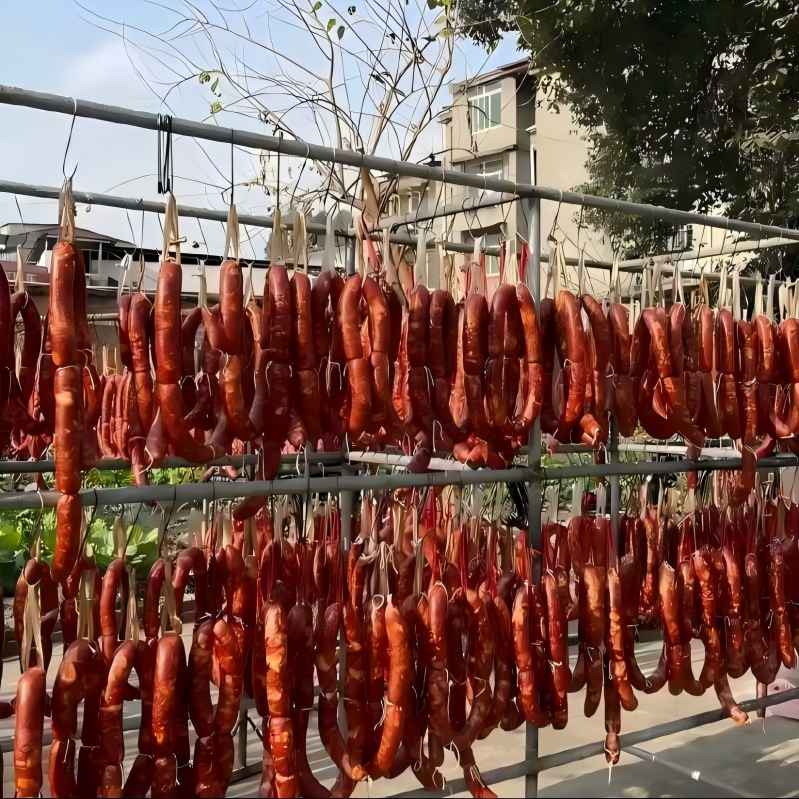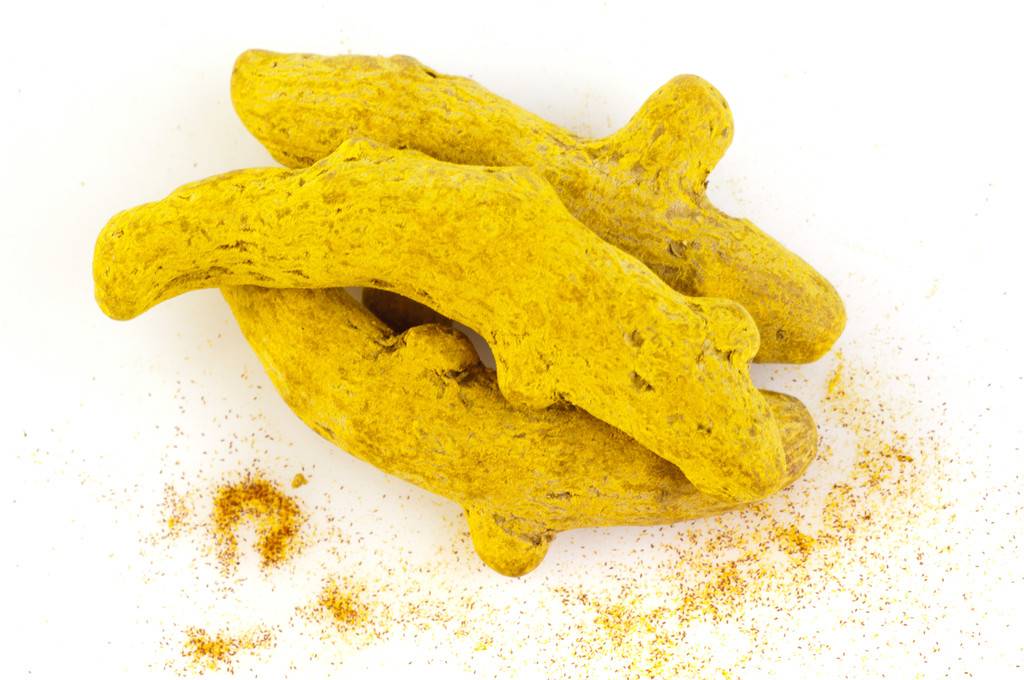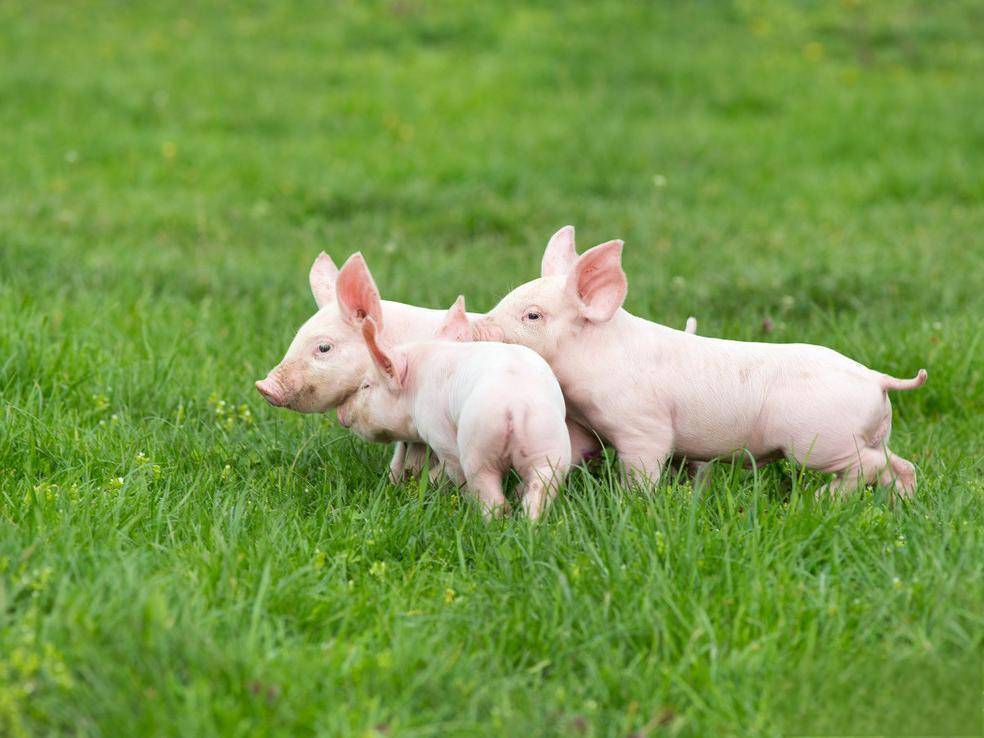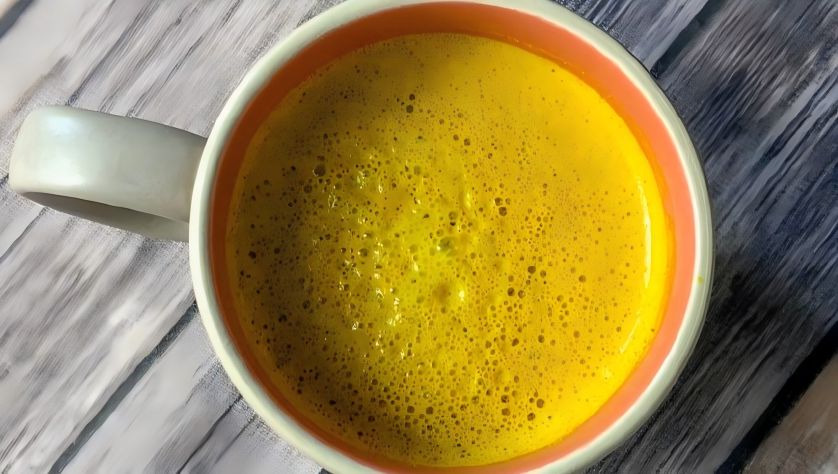What Are the Extraction Methods of Turmeric Powder?
Meat contains a variety of essential nutrients for the human body, such as protein, essential amino acids, iron, and zinc. However, meat is prone to lipid oxidation and microbial contamination, which causes it to spoil and deteriorate, resulting in huge economic losses [1]. At present, some studies have used natural active ingredients such as curcumin and anthocyanins, which have antioxidant and antibacterial properties, in meat to inhibit lipid oxidation and microbial growth and extend its shelf life. It has also been found that pH-sensitive pigments such as curcumin, anthocyanins and chlorophyll can be used to monitor changes in meat quality [2].
Turmeric is a traditional spice plant that is commonly used in food processing. The main bioactive ingredient in turmeric is curcumin, which is found in approximately 2% to 9% of the turmeric rhizome [3]. Curcumin is a yellow polyphenol composed of two benzene rings connected by a methoxy group and a hydroxyl group, with a β-diketone and a carbon chain connected in the middle, and a keto-enol tautomeric structure [3], as shown in Figure 1. Curcumin has a spicy taste, is insoluble in water, and is easily soluble in solvents such as ethanol, acetone, and alkali solutions [3-6]. It is sensitive to pH and has various biological activities such as antioxidant, antibacterial, anti-inflammatory, and anticancer activities [2, 7]. At present, curcumin is obtained from the rhizome of turmeric, but different extraction methods will affect the yield of curcumin. At the same time, there is no systematic summary of the application of curcumin in meat in domestic and foreign papers. Therefore, this paper focuses on reviewing the extraction methods, physiological properties and application progress of curcumin in the field of meat products and fresh meat, in order to provide a theoretical reference for the application of curcumin.
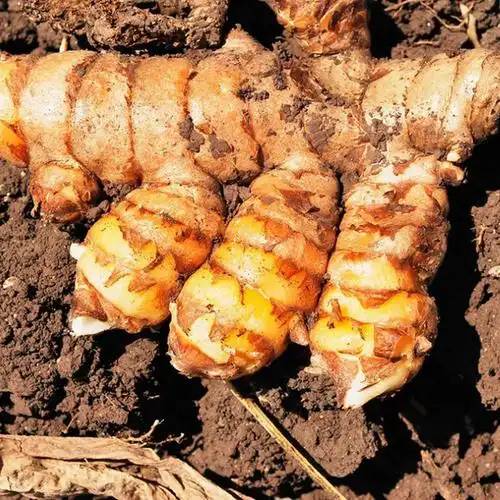
1 Curcumin extraction methods
1.1 Maceration extraction method
The maceration extraction method is a commonly used method for obtaining natural active ingredients. It uses organic solutions, aqueous solutions and other extraction reagents to dissolve the target substances from plants [4]. The yield of the maceration method is mainly related to factors such as the type of solvent, solvent concentration, extraction temperature, extraction time, turmeric particle size, and material-to-liquid ratio [4, 5, 8]. Curcumin is a hydrophobic substance that is often extracted using organic solvents. Ethanol is generally considered to be the best extraction solvent [9]. It has also been found that the yield of curcumin increases with increasing temperature, but that high temperatures can cause curcumin to degrade and reduce the yield [5]. PAULUCCI et al. [8] studied the effect of different conditions on the yield of curcumin. The yield of curcumin was 1.8% when the extraction temperature was 80 °C, the solvent was 96% ethanol, the material-to-liquid ratio was 1:4, the stirring rate was 70 r/min, and the extraction time was 24 h. It was also found that the concentration of ethanol is an important factor affecting the yield of curcumin.
In addition to organic solvents, alkali solutions can also be used for extraction. OTHMAND [6] used 2 mol/L sodium hydroxide solution to extract curcumin by immersion for 0.5 h, and obtained a total of 12.95±1.07 mg of curcumin from each gram of freeze-dried turmeric powder. It was also found that the alkali solution did not reduce the antioxidant activity and antibacterial activity of curcumin. Due to the disadvantages of traditional reagents, such as high volatility and toxicity, some researchers have developed ionic solutions as green solvents to extract curcumin. These ionic solutions have the characteristics of low volatility, high thermal stability, and adjustable viscosity [10]. At the same time, ionic liquids can dissolve cellulose and destroy the cell walls of turmeric, thus increasing the yield of curcumin [11]. BUSRA et al. [10] used 1-butyl-3-methylimidazolium bis(trifluoromethylsulfonyl)imide ionic liquid to extract curcumin, with a maximum yield of 2.94% in the laboratory.
1.2 Soxhlet extraction
Soxhlet extraction is a common method for extracting natural active ingredients from plants. The principle is that the solvent vapor in the round-bottomed flask comes into contact with the turmeric in the thimble and extracts curcumin. When the liquid in the thimble reaches the overflow layer, the liquid containing curcumin returns to the round-bottomed flask through the siphon tube. The separated solvent is reintroduced into the thimble for repeated extraction of curcumin, which reduces the consumption of volatile reagents [9, 12]. SHIRSATH [9] obtained 12.75 mg of curcumin per gram of turmeric powder from a batch extraction at 78 °C, a particle size of 0.09 mm, a liquid-to-material ratio of 1:25, and an extraction time of 8 h using ethanol as the solvent. Compared with the batch extraction method, the Soxhlet extraction method has a higher yield but takes longer. In order to shorten the extraction time, some studies use ultrasonic, microwave and other techniques to assist in the Soxhlet extraction of curcumin [4].
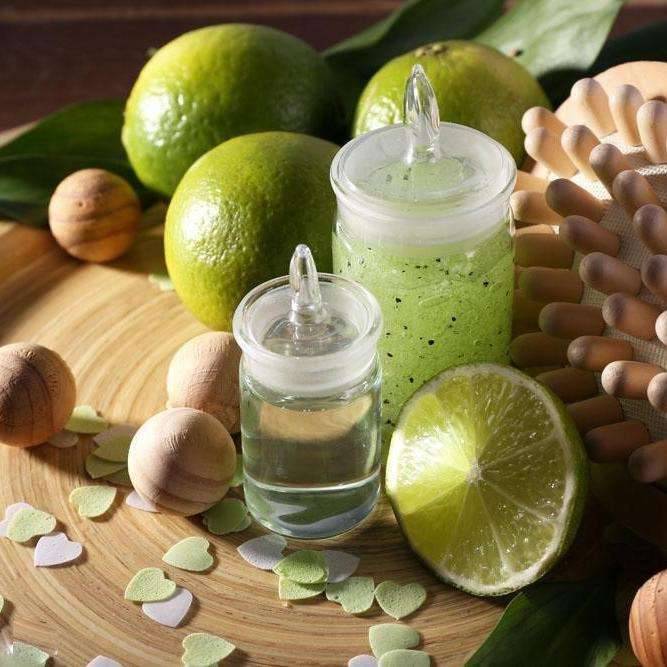
1.3 Pressurized liquid extraction
Pressurized liquid extraction is a method of increasing the boiling point of a solvent by increasing the pressure [13]. The high temperature and pressure are then used to accelerate the mass transfer rate between the solute and solvent and improve the extraction capacity. Pressurized liquid extraction has the characteristics of short extraction time, high yield, and low solvent consumption [14]. CHAO et al. [14] determined the optimal extraction conditions through single-factor experiments: turmeric particle size 0.20–0.30 mm, ethanol as the extraction solvent, temperature 100 °C, pressure 1500 psi (approximately 10.34 MPa), static extraction for 5 min, cycle 1, rinse 60%, and used for the extraction of turmeric from 12 products, and 10.16 to 16.48 mg of curcumin was obtained from each gram of turmeric sample.
When water is used as the extraction solvent, pressurized liquid extraction is also referred to as subcritical water extraction. KIAMAHALLEH et al. [15] used subcritical water extraction under the optimal extraction conditions: particle size 0.71 mm, temperature 140 °C, pressure 1 MPa, extraction time 14 min, using subcritical water extraction, the curcumin yield was 3.8%. OSORIO-TOBON et al. [16] used a combined process of pressurized liquid extraction and supercritical CO2 fluid extraction for the extraction of curcumin, that is, the essential oil in the turmeric rhizome was extracted using supercritical CO2 fluid, and then the curcumin was extracted from the treated turmeric rhizome using pressurized liquid, with a final yield of 4.3% ± 0.2%. Turmeric essential oil has a pungent odor that can affect the sensory of food, and curcumin, which removes turmeric essential oil, has broader application prospects in food.
1.4 Ultrasonic-assisted extraction
Ultrasonic-assisted extraction is a traditional extraction method that uses ultrasound as an aid. The principle is that ultrasound can break the cell walls of plants to promote the release of substances. At the same time, the turbulence and solution circulation caused by the cavitation effect can enhance the mass transfer rate of the system, thereby accelerating the extraction rate [9, 12]. Ultrasound frequency and power are important factors affecting the yield. SHIRSATH et al. [9] used ultrasonic-assisted Soxhlet extraction. After 8 h of Soxhlet extraction in the control group, 12.75 mg of curcumin was obtained from each gram of turmeric powder.
However, when the ultrasonic frequency was 22 kHz, the ultrasonic power was 250 W, the extraction temperature was 35 °C, the extraction time was 1 h, and the remaining parameters were the same, 9.18 mg of curcumin was obtained from each gram of turmeric powder. It was found that ultrasonic assistance greatly reduced the extraction time and reduced energy consumption. Ultrasonic-assisted extraction can also increase the curcumin yield. PATIL [17] used ultrasonic-assisted chlorinated choline-lactic acid eutectic solvent extraction to extract curcumin, and 20 min obtained 77.13 mg of curcumin per gram of dried turmeric powder, which was shorter than using only the eutectic solvent (75 min), and the yield was increased by 16.67%. It has been reported that nano-curcumin can be obtained by directly treating a mixture of turmeric powder and water with probe ultrasound, which increases the water solubility of curcumin and is beneficial to improving the biological activity of curcumin [18].
1.5 Microwave-assisted extraction
The cell walls of turmeric are mainly composed of cellulose. The thermal effect of microwave radiation can promote the degradation of cellulose, causing damage to the cell walls and accelerating the release of curcumin. At the same time, microwave treatment can increase the diffusion rate of the solvent, thereby accelerating the extraction rate. Microwave-assisted extraction also has the advantages of short extraction time and high yield [19].
Microwave power and microwave treatment time are important factors affecting the yield [20]. WAKTE et al. [20] first pretreated the water-soaked turmeric powder with microwave irradiation (270 W) for 7 min, and then extracted it with acetone at 60 W microwave power for 5 min. The maximum yield was 1.9%, while the yield using acetone Soxhlet reflux extraction for 8 h yielded only 2.1%, indicating that microwave-assisted extraction can significantly shorten the extraction time. MANDAL et al. [21] also showed that microwave-assisted extraction is shorter and has a higher yield than maceration extraction, stirring extraction, and Soxhlet reflux extraction. With the development of microwave-assisted technology, methods such as vacuum microwave-assisted extraction (VMAE), nitrogen-protected microwave-assisted extraction (NPMAE), ultrasonic microwave-assisted extraction (UMAE) and dynamic microwave extraction (DMAE) have been developed to improve the ability of microwave-assisted extraction [22].
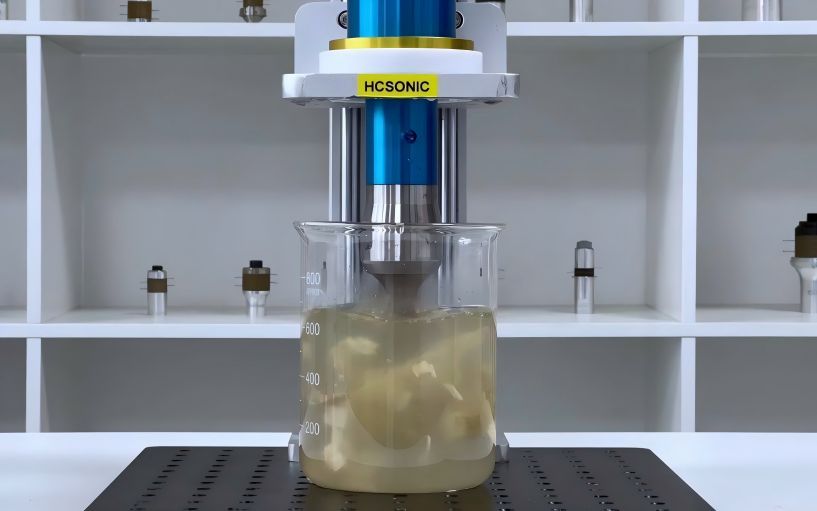
1.6 Enzyme-assisted extraction
Enzyme-assisted extraction uses enzymes to break down the structure of the turmeric cell wall and promote the release of curcumin [23], thereby increasing the yield of curcumin. Enzymes are specific and have specificity, so the type of enzyme is an important factor affecting the yield. α-Amylase, amyloglucosidase [3], cellulase [11, 24] and glucoamylase [23] are often used for processing. The use of enzyme assistance can significantly increase the curcumin yield. SAHNE [3] added α-amylase and amyloglucosidase to pretreat turmeric powder, and then used an N,N-dipropylammonium-N′, N ′-dipropylcarbamate) ionic solution was used for extraction. Compared with the control group, the curcumin yield increased from 3.58% to 5.73%, and the purity reached 96%. In addition, the amount of enzyme, enzymatic hydrolysis time, enzymatic hydrolysis pH, and enzymatic hydrolysis temperature also affect the yield [24]. Ningna et al. [24] found that cellulase-assisted microwave extraction can increase the curcumin yield, and obtained the optimal enzyme treatment conditions: the amount of cellulase (10,000 U/g) was 9.8 mg/g (enzyme: turmeric), the enzymatic hydrolysis time was 75 min, the pH was 4.7, and the temperature was 43 °C. Finally, 21.96 mg of curcumin was obtained from each gram of turmeric, which is better than the use of microwave-assisted extraction of curcumin alone.
2 Physiological properties of curcumin
2.1 Antioxidant activity
Curcumin is a polyphenol extracted from turmeric, and has a good ability to scavenge active oxygen, nitrogen dioxide radicals, superoxide anions, hydroxyl radicals and 1,1-diphenyl-2-trinitrophenylhydrazine (DPPH) radicals [25]. The principle of its antioxidant effect is that the phenolic hydroxyl and methylene groups can provide H atoms and react with free radicals to scavenge them [26]. Studies have also shown that curcumin can inhibit the activity of lipoxygenase, cyclooxygenase and xanthine oxidase, thereby inhibiting the production of reactive oxygen species [27].
Curcumin has good antioxidant capacity. NAKSURIYA et al. [25] compared the scavenging rates of different antioxidants for DPPH radicals and found that curcumin's antioxidant activity was significantly higher than that of ascorbic acid and garcinia flavone, and slightly lower than that of gallic acid. The antioxidant activity of curcumin increased with its concentration. MA et al. [26] found that the addition of curcumin can greatly enhance the antioxidant capacity of the film. The DPPH scavenging rate of the control film was only 1.81%, while the DPPH scavenging capacity of the film increased with the increase of curcumin content (1%→5%), from 7.81% to 35.16%. Curcumin has the ability to inhibit lipid oxidation in meat. ABDOU [28] showed that the film containing curcumin can significantly reduce the malondialdehyde (MDA) content in chicken meat and inhibit lipid oxidation compared with the control group. Therefore, curcumin is an excellent antioxidant that can be used in meat to prevent oxidation and in antioxidant active films.
2.2 Bacteriostatic activity
Studies have shown that curcumin has a good inhibitory effect on bacteria such as Escherichia coli, Staphylococcus aureus, Staphylococcus epidermidis, Pseudomonas aeruginosa[6], Listeria monocytogenes, Salmonella typhimurium[7], Bacillus subtilis[29], and also has a certain inhibitory effect on fungi such as the genus Candida and the genus Aspergillus[6]. The main antibacterial mechanisms of curcumin are currently believed to be: (1) Curcumin can bind to the filamentous temperature-sensitive mutant Z (FtsZ), which is required for bacterial division, inhibiting the formation of the Z ring and thus inhibiting bacterial division [29]. (2) Curcumin can destroy the integrity of the cell membrane, causing leakage of the cytoplasm, thereby inhibiting the bacteria [30].
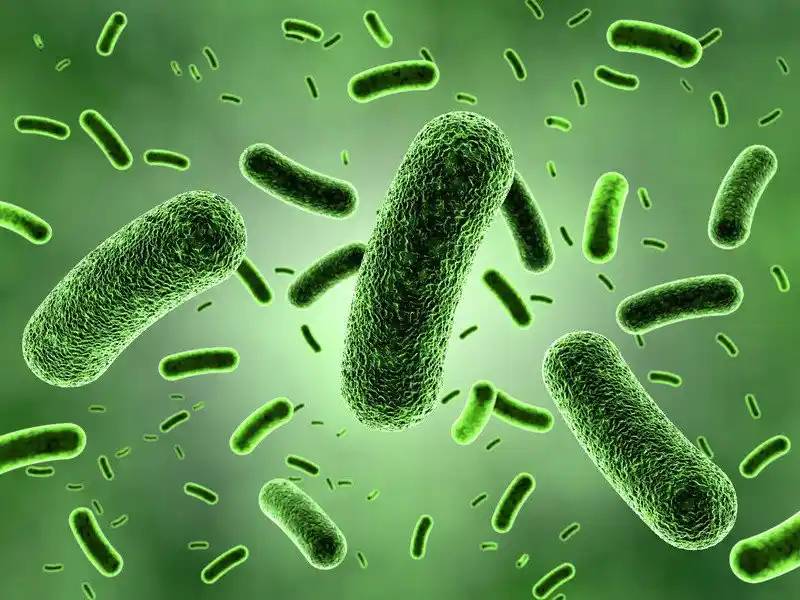
Curcumin has a good bacteriostatic effect, and its bacteriostatic effect is positively correlated with its concentration. OTHMAN [6] found that as the concentration of curcumin increased, the larger the bacteriostatic zone produced. ALTUNATMAZ et al. [7] also showed that the bacteriostatic effect is related to the concentration of curcumin. Minced meat was inoculated with 104 CFU/g bacteria and different concentrations of curcumin were added. After 7 days of incubation, it was found that the addition of 1% curcumin reduced the plate counts of Staphylococcus aureus, Salmonella typhimurium, Escherichia coli O157:H7 and Listeria monocytogenes by 1.84, 1.87, 2.24 and 1.48 lgCFU/g, respectively while the addition of 2% curcumin reduced the plate count by (3.15, 2.42, 2.31, 2.91 lgCFU/g) respectively. At the same time, the bacteriostatic effect of curcumin is also related to the type of microorganism. For example, the minimum inhibitory concentration (MIC value) of curcumin against Listeria monocytogenes and Staphylococcus aureus is 125 μg/ml, the MIC value for Salmonella typhimurium and Escherichia coli O157:H7 is 250 μg/ml [7]; and 10 mg/mL curcumin has no significant inhibitory effect on fungi of the genus Trichoderma [6]. Curcumin has a good inhibitory effect on foodborne pathogenic bacteria and can be used as a natural antimicrobial agent in the meat industry.
2.3 pH indicator
Curcumin has the ability to indicate pH changes, and it displays different colors at different pHs. Under acidic conditions (pH 3.0–7.0), curcumin is yellow, while under alkaline conditions (pH ≥ 8.0), the color changes to orange or red [31]. The change in the color of curcumin may be related to changes in its structure. Under acidic conditions, curcumin mainly adopts a β-diketone structure, while under alkaline conditions, it adopts a ketene-enol structure [32].
At the same time, some studies have found that an alkaline environment causes a conjugate effect of electron cloud deviation of the hydroxyl groups at both ends of curcumin, so the color changes from orange-yellow to red [33]. XIAO et al. [34] added curcumin to an intelligent film and immersed it in phosphate buffer solutions with different pH (3.0, 5.0, 7.0, 9.0 and 11.0). found that at pH 3.0 to 7.0, the color of the film was light yellow. As the pH continued to rise, the color of the film changed significantly. At pH 9.0, the color was orange, and at pH 11.0, the color turned red. It was also found that the color change trend of the curcumin smart film was consistent with that of the curcumin solution, indicating that the film did not affect the pH indicator effect of curcumin. Therefore, curcumin can be used in smart packaging to indicate changes in pH.
3 Curcumin in meat products and fresh meat
3.1 Curcumin in meat products
Curcumin can be used in meat processing to reduce lipid oxidation. Meat products such as sausages [35, 36] and meat patties [37] contain high levels of fat. Lipid oxidation produces substances such as aldehydes, alkanes and alkenes, which have an off-flavor or rancid taste [38] and can reduce the quality of the meat product. Curcumin has antioxidant biological activity, and the addition of curcumin to meat products can inhibit lipid oxidation. and is therefore often used as a food antioxidant in meat processing. MURAOKA et al. [35] added 0.002% by mass of curcumin microcrystals to sausage, which significantly reduced the MDA content. After 90 days of storage, the MDA content was 1.11 mg/kg, which was lower than the 3.10 mg/kg of the control group. However, the smell of curcumin reduced the sensory score of the sausage. Adding fat substitutes can reduce the fat content of meat products [36] and is an effective way to inhibit lipid oxidation.
LI et al. [36] added a curcumin-containing milk gel fat substitute to sausages and found that the addition of curcumin further inhibited fat oxidation and reduced the cooking loss of the sausages. The preparation of oil gel fat substitutes using vegetable oil or marine fish oil is rich in unsaturated fatty acids and is more in line with human health. However, the high-temperature treatment required for oil gel preparation can cause lipid oxidation. The addition of curcumin can reduce lipid oxidation during oil gel preparation, and can also inhibit lipid oxidation during cooking and storage of meat patties [37].
High-protein meat products can produce heterocyclic aromatic amines during high-temperature processing, which poses a certain carcinogenic risk [39]. Curcumin can reduce the content of heterocyclic amines in meat products. WANG et al. [39] found that curcumin can reduce the content of the heterocyclic aromatic amines Norharman and Harman in braised pork. The mechanism of action is to inhibit the formation of the heterocyclic aromatic amine precursor carbonyl compounds and 1,2,3,4-tetrahydro-β-carboline-3-carboxylic acid (THCA), and it can also directly remove heterocyclic aromatic amines to ensure the health and safety of food.
3.2 Curcumin-active film in fresh meat
During storage and sale, meat is subject to microbial and enzymatic action, which causes protein degradation, lipid oxidation, etc., producing off-flavors or foul odors, reducing meat quality, and causing huge economic losses to the meat industry. Biodegradable film is a new type of packaging material that differs from traditional plastic packaging. Its greatest feature is that it is biodegradable and can reduce environmental pollution [40], and it is widely used in the preservation of fresh meat.
Adding curcumin to the film can extend the shelf life of fresh meat because curcumin has antioxidant and antibacterial properties, and the physical isolation of the film can also reduce contact between fresh meat and the external environment. Many studies have shown that the use of curcumin-activated films for the storage of lamb [1], chicken [28, 41], pork [40, 42] and fish [43] can delay spoilage and extend the shelf life. Xie et al. [40] added curcumin to a potato film containing bacterial cellulose to improve the film's antioxidant capacity, and used for pork storage (4±1 ℃). Compared with the blank control group, covering pork with a film containing curcumin can significantly reduce the MDA content and the pork has the lowest oxidation degree. However, the low solubility of curcumin in water may affect its antioxidant and antibacterial activities.
At present, there are some studies on the preparation of curcumin nanoparticles and curcumin nanoemulsions to improve the water solubility and biological activity of curcumin. SHEN et al. [42] used ionic cross-linking technology to prepare curcumin nanoparticles, which greatly improved their water solubility (0.017 μg/mL → 35.92 μg/mL). and added to a sodium hydroxypropyl cellulose film for the preservation of pork (4±1 °C). It was found that at the same concentration, the nanoparticles had better antioxidant activity. The MDA content on the 15th day was 0.248 mg/kg, which was significantly lower than that of the ordinary curcumin film group.
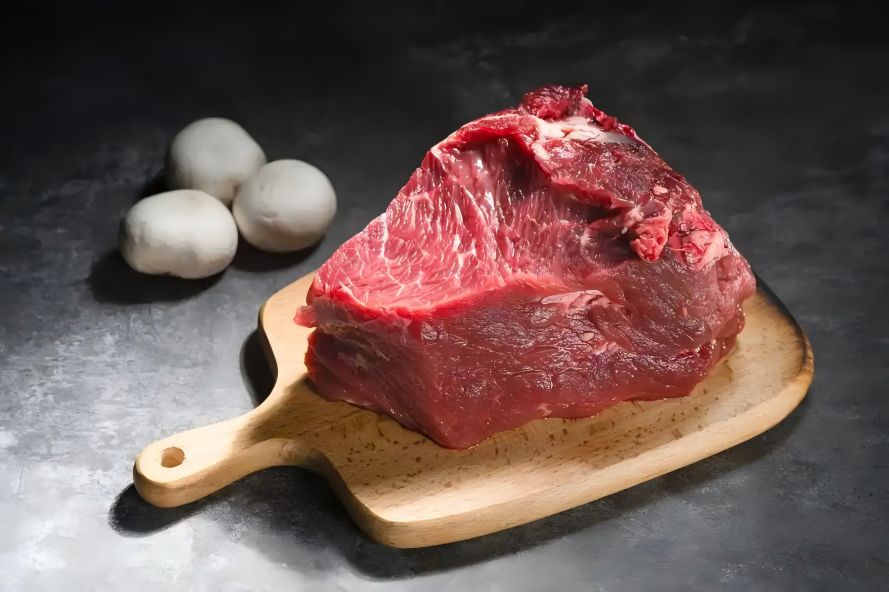
KHAN et al. [41] added a curcumin nanoemulsion to an edible gelatin composite film. the DPPH scavenging rate of the film can reach 60.51%, and it also has a good inhibitory effect on foodborne pathogenic bacteria such as Escherichia coli and Salmonella typhimurium. It can extend the storage time of chicken (4 ℃) to 17 days, outperforming traditional plastic packaging. ABDOU et al. [28] also found that the turmeric nanoemulsion-pectin coating not only extended the storage period of chicken, but also better preserved the quality of the chicken. Compared with the control group, the experimental group had better water retention and muscle texture, which may be due to the fact that curcumin can inhibit the growth of spoilage microorganisms and thus inhibit the degradation of chicken protein. Therefore, turmeric-containing films have great potential in the preservation of fresh meat.
3.3 Application of curcumin smart film in indicating the quality of fresh meat
In recent years, smart packaging has been widely used to monitor the quality changes during the storage of fresh meat. Its greatest feature is that it can reflect the changes in food quality through the color changes of the indicator, without the need for testing, and the quality of the product can be directly communicated to consumers [44]. Natural plant pigments such as curcumin, anthocyanins, betalains, and chlorophyll are often used as indicators in smart packaging [2]. Curcumin is a natural pigment extracted from turmeric. It exhibits color sensitivity to pH, which makes it a suitable indicator for smart packaging. Total volatile basic nitrogen (TVBN) is a general term for alkaline nitrogenous substances such as ammonia or amines produced by the decomposition of proteins in meat due to the action of microorganisms during storage. The production of TVBN will increase the pH of the environment [45]. Therefore, the quality of fresh meat can be reflected by the change in the color of curcumin. At present, curcumin-based smart films have been used to monitor the quality of fresh meat such as shrimp[31, 34], chicken[32], pork[45, 46], beef[47] and fish[48].
LIU et al.[45] added chitosan-coated curcumin microcapsules to a sodium hydroxypropyl methyl cellulose film and used to monitor the quality changes of pork during refrigeration (4 ℃). After 2 days of storage, the TVBN content of the pork was 15.12 mg/100g, the pH was 6.25, the pork had changed from fresh to not fresh, and the color of the film had changed from light yellow to dark yellow, indicating that the curcumin smart film has the function of indicating the freshness of the pork. Shrimp and other aquatic products are prone to spoilage during storage, so their freshness needs to be monitored. ZHANG et al. [31] added curcumin and agar to polyvinyl alcohol to prepare pH indicator films for use in a study of chilled shrimp (4 °C). The results showed that the shrimp had spoiled after 36 h, the film color had turned orange, At 60 h, the TVBN content in the shrimp meat reached 56.8 mg/100 g, and the meat was severely spoiled, with the color of the film turning orange-red. As the fresh meat spoiled, the color of the curcumin film also changed significantly, and there was a positive correlation with the TVBN content. The film can effectively monitor the quality changes during the storage of fresh meat.
4 Conclusion
Curcumin has antioxidant, antibacterial biological activity and pH indicator ability. A large number of studies have shown that curcumin can effectively inhibit lipid oxidation and microbial growth, thereby extending the shelf life of meat and meat products and reducing food waste. At the same time, the intelligent curcumin film can nondestructively reflect the freshness and degree of spoilage of meat and intuitively convey this to consumers, so it has broad application prospects in the field of meat. However, further research is still needed in the following areas: (1) The traditional curcumin extraction method requires a large amount of organic solvents and a long time.
Therefore, a more efficient, green and inexpensive method for preparing curcumin and realizing large-scale production of curcumin can be used. (2) Curcumin has a certain pungent taste, which limits its application to a certain extent. Therefore, it is necessary to study the deodorization and masking of curcumin. (3) The antioxidant and antibacterial activities of curcumin make a significant contribution to its use in meat products and meat. It can increase the water solubility of curcumin to enhance its biological activity, or study the synergistic effect with other active ingredients. (4) Curcumin-based active and intelligent films have potential applications in meat preservation and spoilage indicators. However, their effects on different types of meat still need to be studied to broaden their scope of application.
Reference:
[1] FALLAH A A, SARMAST E, DEHKORDI S H, et al. Low-dose gamma irradiation and pectin biodegradable nanocomposite coating containing curcumin nanoparticles and ajowan (Carum copticum) essential oil nanoemulsion for storage of chilled lamb loins[J] . Meat Science, 2022, 184: 108700, DOI: 10.1016/j.meatsci.2021.108700 .
[2] BHARGAVA N, SHARANAGAT V S, MOR R S, et al. Active and intelligent biodegradable packaging films using food and food waste- derived bioactive compounds: A review[J] . Trends in Food Science & Technology, 2020, 105: 385-401.
[3] SAHNE F, MOHAMMADI M, NAJAFPOUR G D, et al. Enzyme-assisted ionic liquid extraction of bioactive compound from turmeric (Curcuma longa L.): Isolation, purification and analysis of curcumin[J] . Industrial Crops and Products, 2017, 95: 686-694.
[4] JIANG T, GHOSH R, CHARCOSSET C. Extraction, purification and applications of curcumin from plant materials-A comprehensive review[J] . Trends in Food Science & Technology, 2021, 112: 419-430.
[5] SOGI D S, SHARMA S, OBEROI D P S, et al. Effect of extraction parameters on curcumin yield from turmeric[J] . Journal of Food Science and Technology, 2010, 47(3): 300-304.
[6] OTHMAN R, ABDURASID M A, MAHMAD N, et al. Alkaline-based curcumin extraction from selected zingiberaceae for antimicrobial and antioxidant activities[J] . Pigment & Resin Technology, 2019, 48(4): 293-300.
[7] ALTUNATMAZ S S, AKSU F Y, ISSA G, et al. Antimicrobial effects of curcumin against L. monocytogenes, S. aureus, S. Typhimurium and E. coli O157:H7 pathogens in minced meat[J] . Veterinarni Medicina, 2016, 61(5): 256-262.
[8] PAULUCCI V P, COUTO R O, TEIXEIRA C C C, et al. Optimization of the extraction of curcumin from Curcuma longa rhizomes[J] . Revista Brasileira de Farmacognosia, 2013, 23(1): 94-100.
[9] SHIRSATH S R, SABLE S S, GAIKWAD S G, et al. Intensification of extraction of curcumin from Curcuma amada using ultrasound assisted approach: Effect of different operating parameters[J] . Ultrasonics Sonochemistry, 2017, 38: 437-445.
[10] GOKDEMIR B, BAYLAN N, CEHRELI S. Application of a Novel Ionic Liquid as an Alternative Green Solvent for the Extraction of Curcumin from Turmeric with Response Surface Methodology: Determination and Optimization Study[J] . Analytical Letters, 2020, 53(13): 2111-2121.
[11]TAN S, SI R Y, QIANG Y Y, et al. Optimization of the Extraction Process of Curcuminoid by lonic Liquid-assisted Enzymatic Method[J/OL]. Science and Technology of Food Industry. 2022. DOI:10.13386/j.issn1002-0306.2021120114 .
[12] JADHAV D, REKHA B N, GOGATE P R, et al. Extraction of vanillin from vanilla pods: A comparison study of conventional soxhlet and ultrasound assisted extraction[J] . Journal of Food Engineering, 2009, 93(4): 421-426.
[13] ZHONG X, GUO J L, TONG X W, et al. Optimization of extraction process of polysaccharide from Armillaria mellea by pressurized liquid method and evaluation of antioxidative activity[J] . Cereals & Oils, 2019,32(5):93-96 .
[14] CHAO I C, WANG C M, LI S P, et al. Simultaneous Quantification of Three Curcuminoids and Three Volatile Components of Curcuma longa Using Pressurized Liquid Extraction and High-Performance Liquid Chromatography[J] . Molecules, 2018, 23(7): 1568, DOI:10.3390/molecules23071568 .
[15] KIAMAHALLEH M V, NAJAFPOUR-DARZI G, RAHIMNEJAD M, et al. High performance curcumin subcritical water extraction from turmeric (Curcuma longa L.)[J] . Journal of Chromatography B, 2016, 1022: 191-198.
[16] OSORIO-TOBON J F, CARVALHO P I N, ROSTAGNO M A, et al. Extraction of curcuminoids from deflavored turmeric (Curcuma longa L.) using pressurized liquids: Process integration and economic evaluation[J] . The Journal of Supercritical Fluids, 2014, 95: 167-174.
[17] PATIL S S, PATHAK A, RATHOD V K. Optimization and kinetic study of ultrasound assisted deep eutectic solvent based extraction: A greener route for extraction of curcuminoids from Curcuma longa[J] . Ultrasonics Sonochemistry, 2021, 70: 105267, DOI: 10.1016/j.ultsonch.2020.105267 .
[18] GOPAL J, MUTHU M, CHUN S-C. One-step, ultrasonication-mobilized , solvent-free extraction/synthesis of nanocurcumin from turmeric[J] . RSC Advances, 2015, 5(60): 48391-48398.
[19] DANDEKAR D V, GAIKAR V G. Microwave assisted extraction of curcuminoids from Curcuma longa[J] . Separation Science and Technology, 2002, 37(11): 2669-2690.
[20] WAKTE P S, SACHIN B S, PATIL A A, et al. Optimization of microwave, ultra-sonic and supercritical carbon dioxide assisted extraction techniques for curcumin from Curcuma longa[J] . Separation and Purification Technology, 2011, 79(1): 50-55.
[21] MANDAL V, MOHAN Y, HEMALATHA S. Microwave assisted extraction of curcumin by sample-solvent dual heating mechanism using Taguchi L9 orthogonal design[J] . Journal of Pharmaceutical and Biomedical Analysis, 2008, 46(2): 322-327.
[22] CHAN C H, YUSOFF R, NGOH G C, et al. Microwave-assisted extractions of active ingredients from plants[J] . Journal of Chromatography A, 2011, 1218(37): 6213-6225.
[23] KURMUDLE N N, BANKAR S B, BAJAJ I B, et al. Enzyme-assisted three phase partitioning: A novel approach for extraction of turmeric oleoresin[J] . Process Biochemistry, 2011, 46(1): 423-426.
[24] NING N, HAN J J, HU Y L, et al. Study on Microwave- assisted Enzyme Extraction Process for Curcumin from Curcuma longa[J] . Chinese Journal of Veterinary Drug, 2015, 49(12): 20-26.
[25] NAKSURIYA O, OKONOGI S. Comparison and combination effects on antioxidant power of curcumin with gallic acid, ascorbic acid, and xanthone[J] . Drug Discoveries & Therapeutics, 2015, 9(2): 136-141.
[26] MA Q Y, REN Y M, WANG L J. Investigation of antioxidant activity and release kinetics of curcumin from tara gum/polyvinyl alcohol active film[J] . Food Hydrocolloids, 2017, 70: 286-292.
[27] Hewlings S J, Kalman D S. Curcumin: A Review of Its Effects on Human Health[J] . Foods, 2017, 6(10): 92, DOI:10.3390/foods6100092.
[28] ABDOU E S, GALHOUM G F, MOHAMED E N. Curcumin loaded nanoemulsions/pectin coatings for refrigerated chicken fillets[J] . Food Hydrocolloids, 2018, 83: 445-453.
[29] RAI D, SINGH J K, ROY N, et al. Curcumin inhibits FtsZ assembly: an attractive mechanism for its antibacterial activity[J] . Biochemical Journal, 2008, 410: 147-155.
[30] TYAGI P, SINGH M, KUMARI H, et al. Bactericidal Activity of Curcumin I Is Associated with Damaging of Bacterial Membrane[J] . Plos One, 2015, 10(3): e0121313 . DOI10.1371/journal.pone.0121313 .
[31] ZHANG J J, HUANG X W, ZOU X B, et al. A visual indicator based on curcumin with high stability for monitoring the freshness of freshwater shrimp, Macrobrachium rosenbergii[J] . Journal of Food Engineering, 2021, 292: 110290. DOI: 10.1016/j.jfoodeng.2020.110290.
[32] YILDIZ E, SUMNU G, KAHYAOGLU L N. Monitoring freshness of chicken breast by using natural halochromic curcumin loaded chitosan/PEO nanofibers as an intelligent package[J] . International Journal of Biological Macromolecules, 2021, 170: 437-446.
[33] Liu J R. Research on the preparation, properties and application of pH-sensing smart food packaging films[D] . Hefei, Hefei University of technology, 2019.
[34] XIAO Y Q, LIU Y N, KANG S F, et al. Development of pH-responsive antioxidant soy protein isolate films incorporated with cellulose nanocrystals and curcumin nanocapsules to monitor shrimp freshness[J] . Food Hydrocolloids, 2021, 120: 106893. DOI: 10.1016/j.foodhyd.2021.106893 .
[35] MURAOKA J M, DE OLIVEIRA T P, GONCALVES O H, et al. Substitution of synthetic antioxidant by curcumin microcrystals in mortadella formulations[J] . Food Chemistry, 2019, 300: 125231. DOI: 10.1016/j.foodchem.2019.125231 .
[36] LI X L, MENG R, XU B C, et al. Function emulsion gels prepared with carrageenan and zein/carboxymethyl dextrin stabilized emulsion as a new fat replacer in sausages[J] . Food Chemistry, 2022, 389: 133005. DOI10.1016/j.foodchem.2022.133005 .
[37] GOMEZ-ESTACA J, PINTADO T, JIMENEZ-COLMENERO F, et al. The effect of household storage and cooking practices on quality attributes of pork burgers formulated with PUFA- and curcumin-loaded oleogels as healthy fat substitutes[J] . LWT, 2020, 119: 108909. DOI: 10.1016/j.lwt.2019.108909 .
[38] FALOWO A B, FAYEMI P O, MUCHENJE V. Natural antioxidants against lipid-protein oxidative deterioration in meat and meat products: A review[J] . Food Research International, 2014, 64: 171-181.
[39] WANG Q, LI J, LI K K, et al. Effects of turmeric on reducing heterocyclic aromatic amines in Chinese tradition braised meat products and the underlying mechanism[J] . Food Science & Nutrition, 2021, 9(10): 5575-5582.
[40] XIE Y M, NIU X N, YANG J W, et al. Active biodegradable films based on the whole potato peel incorporated with bacterial cellulose and curcumin[J] . International Journal of Biological Macromolecules, 2020, 150: 480-491.
[41] KHAN M R, SADIQ M B, MEHMOOD Z. Development of edible gelatin composite films enriched with polyphenol loaded nanoemulsions as chicken meat packaging material[J] . CyTA - Journal of Food, 2020, 18(1): 137-146.
[42] SHEN W, YAN M Y, WU S, et al. Chitosan nanoparticles embedded with curcumin and its application in pork antioxidant edible coating[J] . International Journal of Biological Macromolecules, 2022, 204: 410-418.
[43] YU Y J, LIN T, YANG S P, et al. The effect of curcumin combined with piperine on quality of salmon(Salmo salar) in cold chain logistics . Food and Fermentation Industries,2021, 47(20): 152-160.
[44] ZENG J, REN X N, WEI J, et al. Preparation and study of responsiveness for chitosan and soy protein isolate based pH response smart labels[J/OL] . Food and Fermentation Industries, 2022. DOI: 10.13995/j.cnki.11-1802/ts.031420 .
[45] LIU Y W, MA Y L, LIU Y, et al. Fabrication and characterization of pH-responsive intelligent films based on carboxymethyl cellulose and gelatin/curcumin/chitosan hybrid microcapsules for pork quality monitoring[J] . Food Hydrocolloids, 2022, 124: 107224.DOI: 10.1016/j.foodhyd.2021.107224 .
[46] LIU J R, WANG H L, WANG P F, et al. Films based on κ-carrageenan incorporated with curcumin for freshness monitoring[J] . Food Hydrocolloids, 2018, 83: 134-142.
[47] ZHAI X D, WANG X Y, ZHANG J J, et al. Extruded low density polyethylene-curcumin film: A hydrophobic ammonia sensor for intelligent food packaging[J] . Food Packaging and Shelf Life, 2020, 26: 100595. DOI: 10.1016/j.fpsl.2020.100595 .
[48] FATHI M, ROSTAMI H, MIRI N Y, et al. Development of an intelligent packaging by incorporating curcumin into pistachio green hull pectin/polyvinyl alcohol (PVA) films[J] . Journal of Food Measurement and Characterization, 2022. DOI: 10.1007/s11694-022-01318-0.


 English
English French
French Spanish
Spanish Russian
Russian Korean
Korean Japanese
Japanese